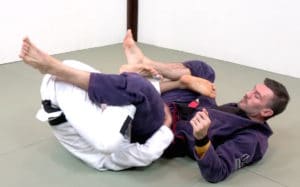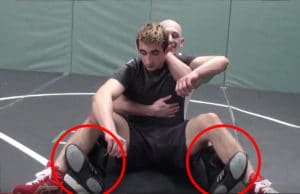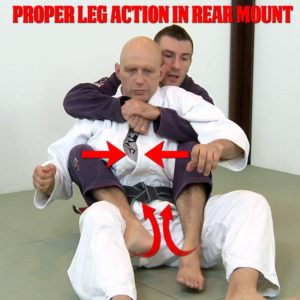The Crab Ride is one of the hottest new positions in BJJ used by competitors like Rafa Mendes, Gianni Grippo, the Miyao brothers, Mikey Musumeci and more.
It looks kind of like you’re doing the butterfly guard on the back of your opponent’s legs with your insteps behind his knees… except that you’re upside down while doing it!
The cool thing is that from that strange position there are a TON of opportunities to take your opponent’s back, enter into submissions, pin him, or just generally frustrate the hell out of your opponent who probably won’t have any clue of what’s going on.
The Crab Ride transitions seamlessly into other techniques and positions including the de la Riva guard, the berimbolo, the rolling backtake, and more.
If you get into this position and your opponent isn’t very skilled at countering it then you’ve basically got a free 4 points for taking the back plus a very decent chance at submitting him outright.
Let’s take a more detailed look at this position…
The Crab Ride in BJJ
The BJJ Crab Ride was developed by Rafa Mendes in the early 2010’s. It has been refined, adapted and added into the games of many other top competitors since then, including the Miyao brothers, Gianni Grippo, Mike Musumeci and many more.
Fundamentally the Crab Ride is a great way of getting to your opponent’s back.
Once you get this position it’s very easy to get your hooks in and get to rear mount if you opponent doesn’t know what to do.
The other main attack from the crab ride is to roll your opponent and come up on top of him.
When you come to the top from a leg drag you’re almost always either in a dominant position like side control and mount, or in a strong leg drag position where you can immediately pass guard.
Finally, being comfortable in this position will also greatly help you make sense of scrambles.
You’ll start seeing opportunities in transitions, and being able to take advantage of those crazy tangled-up positions that everybody who trains ends up in.
In the basic BJJ Crab Ride you’re inverted onto your shoulders, your insteps are behind his knees, and your hands are controlling his belt (gi) or his hips and upper thighs (no gi).
Although it might look strange if you’re not familiar with the position, in the picture below the guy in white is actually in the dominant position and pushing the action. From here he’s only one or two transitions away from landing a submission or jumping on the back of his opponent in the dark gi.

In addition to the basic position shown above there are other, more advanced and effective leg positions in the Crab Ride (including the X control, scissor wedge, twister hook and wedge hook and joystick control). Each of these different leg positions can transition into any of the others and open up different finishing and submission options.
In this situation he who understands the different leg positions and leg pummelling best wins!
There are MANY routes into the Crab Ride. Some of the most common entries start from the de la Riva guard, berimbolo attempts, rolling back takes, leg drags, and double guard pull scenarios.
But if you get comfortable here then you’ll find it easy to get here and your opponents will curse your name!
The Wrestling Crab Ride
In some ways the Crab Ride is not a new position. It’s been around in wrestling for a long time.
Sort of, kind of. It’s similar but different.
As a general rule the BJJ Crab Ride starts from a variety of places and leads to taking the back. The wrestling Crab Ride, on the other hand, starts from the top and progresses towards a pin.
In wrestling the crab ride is used almost entirely as a turnover attack vs the referee’s position, or as a top riding position. It allows control over the opponent’s legs while giving you the option to disengage and go for the pin at almost any point.
Here’s a screen capture from Jason Layton’s Youtube series on the Wrestling Crab Ride showing how the feet are inserted behind the knees with the hooks on the inside for the Crab Ride in wrestling.

Note that although the grips are different (higher on the body instead of on the hips or around the waist) the foot positioning here is identical to the basic BJJ Crab Ride.
To the inexperienced eye this can look like the rearmount. Rearmount and wrestling Crab Rides are similar, but they differ in that the leg positioning for the standard BJJ rear mount has the hooks inside the thighs (you need to get them inside to get the 4 points for rearmount).
Differences Between Wrestling and BJJ Crab Rides
The main difference between the Crab Ride in BJJ and in wrestling is that in BJJ you’re much more likely to play the position upside down.
In wrestling you’d pin yourself and lose the match if you inverted and played the Crab Ride from your shoulders. But in BJJ there are no such restrictions so we can be much more creative with the position.
Also in BJJ the guard is so prevalent (and essentially non-existent in wrestling) that it’s often necessary to invert yourself to get underneath your opponent’s legs and into the Crab Ride position position.
Another difference is in the positioning of your arms.
As has already been pointed out, in wrestling the Crab Ride is usually used with some sort of upper body control (a half nelson, for example).
In BJJ if you were that high on your opponent’s body you would just throw in your hooks to get to rearmount. A BJJ Crab Ride, therefore, typically starts with a grip on the belt, the hips, or very low on the waist, and it’s only over time that you manage to work your way higher and obtain the seatbelt or some other form of upper body control.
While a BJJ style inverting Crab Ride almost never shows up in wrestling the reverse is not true. However you DO occasionally see a wrestling-style Crab Ride in BJJ, submission grappling and MMA.
Most typically this is done to drag a standing opponent to the ground from a rear bearhug.
Imagine this takedown from a standing rear bearhug at the 3 minute mark of this video except with your instep behind his knees instead of your feet. If you topple your opponent in this position then you’re in the wrestling crab ride.
If you learn both a wrestling style AND a BJJ style Crab Ride you’ll be able to switch back and forth between them.
Bottom or top, you’ll be hunting for the Crab Ride and then the back. Your opponents will be running scared no matter where they are.
Have fun!
The post How To Do The Crab Ride in BJJ and No Gi Grappling appeared first on Grapplearts.


